Spatiotemporal Dynamics of Nitrogen Budgets under Anthropogenic Activities in Metropolitan Areas
Abstract
:1. Introduction
2. Materials and Methods
2.1. Study Area
2.2. Accounting for Anthropogenic N Budgets
2.2.1. Non-Point-Source Inputs
2.2.2. Point-Source Inputs
2.2.3. Estimation of N Exports
2.3. Data Sources
2.4. Data Analysis
2.4.1. The Relationship between N Budgets and Anthropogenic Activities
2.4.2. Hotspot Analysis
2.4.3. Sensitivity Analysis
3. Results
3.1. Temporal Dynamics and Sources of Anthropogenic N Inputs
3.2. Temporal Dynamics and Sources of Anthropogenic N Exports
3.3. Overview of N Flows in the Metropolitan Area
3.4. Spatial Patterns and Hotspot Analysis of N Budgets
3.5. Potential Driving Factors of N Budgets
3.6. Dynamic Response of N Exports to N Inputs
4. Discussions
4.1. Anthropogenic N Inputs in the YRDUA
4.2. Influence of Anthropogenic Inputs on Riverine N Exports
4.3. Possible Implications for Reducing N Loading
5. Conclusions
Supplementary Materials
Author Contributions
Funding
Institutional Review Board Statement
Informed Consent Statement
Data Availability Statement
Conflicts of Interest
References
- Galloway, J.N.; Dentener, F.J.; Capone, D.G.; Boyer, E.W.; Howarth, R.W.; Seitzinger, S.P.; Asner, G.P.; Cleveland, C.C.; Green, P.A.; Holland, E.A.; et al. Nitrogen Cycles: Past, Present, and Future. Biogeochemistry 2004, 70, 153–226. [Google Scholar] [CrossRef]
- Galloway, J.N.; Leach, A.M.; Bleeker, A.; Erisman, J.W. A chronology of human understanding of the nitrogen cycle. Philos. Trans. R. Soc. Lond. B Biol. Sci. 2013, 368, 20130120. [Google Scholar] [CrossRef] [Green Version]
- Fowler, D.; Coyle, M.; Skiba, U.; Sutton, M.A.; Cape, J.N.; Reis, S.; Sheppard, L.J.; Jenkins, A.; Grizzetti, B.; Galloway, J.N.; et al. The global nitrogen cycle in the twenty-first century. Philos. Trans. R. Soc. Lond. B Biol. Sci. 2013, 368, 20130164. [Google Scholar] [CrossRef]
- Erisman, J.W.; Galloway, J.N.; Seitzinger, S.; Bleeker, A.; Dise, N.B.; Petrescu, A.M.; Leach, A.M.; de Vries, W. Consequences of human modification of the global nitrogen cycle. Philos. Trans. R. Soc. Lond. B Biol. Sci. 2013, 368, 20130116. [Google Scholar] [CrossRef] [Green Version]
- Gao, B.; Huang, Y.; Huang, W.; Shi, Y.; Bai, X.; Cui, S. Driving forces and impacts of food system nitrogen flows in China, 1990 to 2012. Sci. Total Environ. 2018, 610, 430–441. [Google Scholar] [CrossRef] [PubMed]
- Zhang, W.; Li, X.; Swaney, D.P.; Du, X. Does food demand and rapid urbanization growth accelerate regional nitrogen inputs? J. Clean. Prod. 2016, 112, 1401–1409. [Google Scholar] [CrossRef]
- Isbell, F.; Reich, P.B.; Tilman, D.; Hobbie, S.E.; Polasky, S.; Binder, S. Nutrient enrichment, biodiversity loss, and consequent declines in ecosystem productivity. Proc. Natl. Acad. Sci. USA 2013, 110, 11911–11916. [Google Scholar] [CrossRef] [Green Version]
- Rockström, J.; Steffen, W.; Noone, K.; Persson, Å.; Chapin, F.S.; Lambin, E.F.; Lenton, T.M.; Scheffer, M.; Folke, C.; Schellnhuber, H.J.; et al. A safe operating space for humanity. Nature 2009, 461, 472–475. [Google Scholar] [CrossRef]
- Kaushal, S.S.; Groffman, P.M.; Band, L.; Elliott, E.M.; Shields, C.A.; Kendall, C. Tracking nonpoint source nitrogen pollution in human-impacted watersheds. Environ. Sci. Technol. 2011, 45, 8225–8232. [Google Scholar] [CrossRef] [PubMed]
- Galloway, J.N.; Townsend, A.R.; Erisman, J.W.; Bekunda, M.; Cai, Z.; Freney, J.R.; Martinelli, L.A.; Seitzinger, S.P.; Sutton, M.A. Transformation of the Nitrogen Cycle: Recent Trends, Questions, and Potential Solutions. Science 2008, 320, 889–892. [Google Scholar] [CrossRef] [PubMed] [Green Version]
- Billen, G.; Garnier, J.; Lassaletta, L. The nitrogen cascade from agricultural soils to the sea: Modelling nitrogen transfers at regional watershed and global scales. Philos. Trans. R. Soc. Lond. B Biol. Sci. 2013, 368, 20130123. [Google Scholar] [CrossRef] [PubMed]
- Hong, B.; Swaney, D.P.; Howarth, R.W. Estimating net anthropogenic nitrogen inputs to U.S. watersheds: Comparison of methodologies. Environ. Sci. Technol. 2013, 47, 5199–5207. [Google Scholar] [CrossRef] [PubMed]
- Howarth, R.; Swaney, D.; Billen, G.; Garnier, J.; Hong, B.; Humborg, C.; Johnes, P.; Mörth, C.-M.; Marino, R. Nitrogen fluxes from the landscape are controlled by net anthropogenic nitrogen inputs and by climate. Front. Ecol. Environ. 2012, 10, 37–43. [Google Scholar] [CrossRef] [Green Version]
- Gao, W.; Howarth, R.W.; Swaney, D.P.; Hong, B.; Guo, H.C. Enhanced N input to Lake Dianchi Basin from 1980 to 2010: Drivers and consequences. Sci. Total Environ. 2015, 505, 376–384. [Google Scholar] [CrossRef]
- Zhang, W.; Swaney, D.P.; Hong, B.; Howarth, R.W.; Li, X. Influence of rapid rural-urban population migration on riverine nitrogen pollution: Perspective from ammonia-nitrogen. Environ. Sci. Pollut. Res. Int. 2017, 24, 27201–27214. [Google Scholar] [CrossRef]
- Gao, W.; Swaney, D.P.; Hong, B.; Howarth, R.W.; Liu, Y.; Guo, H. Evaluating anthropogenic N inputs to diverse lake basins: A case study of three Chinese lakes. Ambio 2015, 44, 635–646. [Google Scholar] [CrossRef] [Green Version]
- McIsaac, G.F.; David, M.B.; Gertner, G.Z.; Goolsby, D.A. Nitrate flux in the Mississippi River. Nature 2001, 414, 166–167. [Google Scholar] [CrossRef]
- Huang, J.C.; Lee, T.Y.; Lin, T.C.; Hein, T.; Lee, L.C.; Shih, Y.T.; Kao, S.J.; Shiah, F.K.; Lin, N.H. Effects of different N sources on riverine DIN export and retention in a subtropical high-standing island, Taiwan. Biogeosciences 2016, 13, 1787. [Google Scholar] [CrossRef] [Green Version]
- Zhang, B.-F.; Chen, D.-J. Dynamic response of riverine nitrate flux to net anthropogenic nitrogen inputs in a typical river in Zhejiang Province over the 1980–2010 period. Environ. ENCE 2014, 35, 2911–2919. [Google Scholar]
- Zhang, W.; Li, X.-Y.; Su, J.-J. Responses of riverine nitrogen export to net anthropogenic nitrogen inputs: A review. Chin. J. Appl. Ecol. 2014, 25, 272–278. [Google Scholar]
- Zhang, W.; Li, X.-Y.; Su, J.-J. Response of Riverine Nitrogen Export to Net Anthropogenic Nitrogen Inputs. J. Subtrop. Resour. Environ. 2019, 14, 47–53. [Google Scholar]
- Zhang, X.; Yi, Y.; Yang, Z. Nitrogen and phosphorus retention budgets of a semiarid plain basin under different human activity intensity. Sci. Total Environ. 2020, 703, 134813. [Google Scholar] [CrossRef]
- Huishu, L.; Qiuliang, L.; Xinyu, Z.; Haw, Y.; Hongyuan, W.; Limei, Z.; Hongbin, L.; Huang, J.C.; Tianzhi, R.; Jiaogen, Z.; et al. Effects of anthropogenic activities on long-term changes of nitrogen budget in a plain river network region: A case study in the Taihu Basin. Sci. Total Environ. 2018, 645, 1212–1220. [Google Scholar] [CrossRef] [PubMed]
- Zhang, W.; Li, H.; Li, Y. Spatio-temporal dynamics of nitrogen and phosphorus input budgets in a global hotspot of anthropogenic inputs. Sci. Total Environ. 2019, 656, 1108–1120. [Google Scholar] [CrossRef] [PubMed]
- Howarth, R.W.; Billen, G.; Swaney, D.; Townsend, A.; Jaworski, N.; Lajtha, K.; Downing, J.A.; Elmgren, R.; Caraco, N.; Jordan, T.; et al. Regional nitrogen budgets and riverine N & P fluxes for the drainages to the North Atlantic Ocean: Natural and human influences. Biogeochemistry 1996, 35, 75–139. [Google Scholar]
- Hong, B.; Swaney, D.P.; Howarth, R.W. A toolbox for calculating net anthropogenic nitrogen inputs (NANI). Environ. Model. Softw. 2011, 26, 623–633. [Google Scholar] [CrossRef]
- Swaney, D.P.; Howarth, R.W.; Hong, B. Nitrogen use efficiency and crop production: Patterns of regional variation in the United States, 1987–2012. Sci. Total Environ. 2018, 635, 498–511. [Google Scholar] [CrossRef]
- Zhang, W.S.; Swaney, D.P.; Li, X.Y.; Hong, B.; Howarth, R.W.; Ding, S.H. Anthropogenic point-source and non-point-source nitrogen inputs into Huai River basin and their impacts on riverine ammonia–nitrogen flux. Biogeosciences 2015, 12, 4275–4289. [Google Scholar] [CrossRef] [Green Version]
- Gao, W.; Howarth, R.W.; Hong, B.; Swaney, D.P.; Guo, H.C. Estimating net anthropogenic nitrogen inputs (NANI) in the Lake Dianchi basin of China. Biogeosciences 2014, 11, 4577–4586. [Google Scholar] [CrossRef] [Green Version]
- Chen, Y.; Gao, W.; Wang, D.; Liu, Y.; Wu, Y.; Guo, H. Net anthropogenic nitrogen inputs (NANI) and riverine response in water shortage region: A case study of Haihe River watershed. Acta Sci. Circumstantiae 2016, 36, 3600–3606. [Google Scholar]
- Gao, W.; Gao, B.; Yan, C.; Liu, Y. Evolution of anthropogenic nitrogen and phosphorus inputs to Lake Poyang Basin and its’ effect on water quality of lake. Acta Sci. Circumstantiae 2016, 36, 3137–3145. [Google Scholar]
- Boyer, E.W.; Goodale, C.L.; Jaworski, N.A.; Howarth, R.W. Anthropogenic nitrogen sources and relationships to riverine nitrogen export in the northeastern U.S.A. Biogeochemistry 2002, 57, 137–169. [Google Scholar] [CrossRef]
- Shrestha, S.; Kazama, F.; Newham, L.T.H. A framework for estimating pollutant export coefficients from long-term in-stream water quality monitoring data. Environ. Model. Softw. 2007, 23, 182–194. [Google Scholar] [CrossRef]
- Young, R.A.; Onstad, C.A.; Bosch, D.D.; Anderson, W.P. AGNPS: A nonpoint-source pollution model for evaluating agricultural watersheds. J. Soil Water Conserv. 1989, 44, 168–173. [Google Scholar]
- Johnes, P.J. Evaluation and management of the impact of land use change on the nitrogen and phosphorus load delivered to surface waters: The export coefficient modelling approach. J. Hydrol. 1996, 183, 323–349. [Google Scholar] [CrossRef]
- Shih, Y.T.; Lee, T.Y.; Huang, J.C.; Kao, S.J. Apportioning riverine DIN load to export coefficients of land uses in an urbanized watershed. Sci. Total Environ. 2016, 560, 1–11. [Google Scholar] [CrossRef] [PubMed]
- Worrall, F.; Burt, T.P.; Howden, N.J.K.; Whelan, M.J. The fluvial flux of nitrate from the UK terrestrial biosphere—An estimate of national-scale in-stream nitrate loss using an export coefficient model. J. Hydrol. 2011, 414, 31–39. [Google Scholar] [CrossRef]
- Lu, J.; Gong, D.; Shen, Y.; Liu, M.; Chen, D. An inversed Bayesian modeling approach for estimating nitrogen export coefficients and uncertainty assessment in an agricultural watershed in eastern China. Agric. Water Manag. 2013, 116, 79–88. [Google Scholar] [CrossRef]
- Zhu, J.; Ding, N.; Li, D.; Sun, W.; Xie, Y.; Wang, X. Spatiotemporal Analysis of the Nonlinear Negative Relationship between Urbanization and Habitat Quality in Metropolitan Areas. Sustainability 2020, 12, 669. [Google Scholar] [CrossRef] [Green Version]
- Qin, B.; Xu, P.; Wu, Q.; Luo, L.; Zhang, Y. Environmental issues of Lake Taihu, China. Hydrobiologia 2007, 581, 3–14. [Google Scholar] [CrossRef]
- Han, H.; Allan, J.D. Estimation of nitrogen inputs to catchments: Comparison of methods and consequences for riverine export prediction. Biogeochemistry 2008, 91, 177–199. [Google Scholar] [CrossRef]
- Yanlong, J.; Qiufeng, W.; Jianxing, Z.; Zhi, C.; Nianpeng, H.; Guirui, Y. A spatial and temporal dataset of atmospheric inorganic nitrogen wet deposition in China (1996–2015). China Sci. Data 2019, 4. [Google Scholar] [CrossRef]
- Parfitt, R.L.; Stevenson, B.A.; Dymond, J.R.; Schipper, L.A.; Baisden, W.T.; Ballantine, D.J. Nitrogen inputs and outputs for New Zealand from 1990 to 2010 at national and regional scales. N. Z. J. Agric. Res. 2012, 55, 241–262. [Google Scholar] [CrossRef]
- Ti, C.; Pan, J.; Xia, Y.; Yan, X. A nitrogen budget of mainland China with spatial and temporal variation. Biogeochemistry 2011, 108, 381–394. [Google Scholar] [CrossRef]
- Han, Y.; Fan, Y.; Yang, P.; Wang, X.; Wang, Y.; Tian, J.; Xu, L.; Wang, C. Net anthropogenic nitrogen inputs (NANI) index application in Mainland China. Geoderma 2014, 213, 87–94. [Google Scholar] [CrossRef]
- Wang, A.; Tang, L.; Yang, D.; Lei, H. Spatio-temporal variation of net anthropogenic nitrogen inputs in the upper Yangtze River basin from 1990 to 2012. Sci. China Earth Sci. 2016, 59, 2189–2201. [Google Scholar] [CrossRef]
- Pan, J.; Ding, N.; Yang, J. Changes of urban nitrogen metabolism in the Beijing megacity of China, 2000–2016. Sci. Total Environ. 2019, 666, 1048–1057. [Google Scholar] [CrossRef]
- Li, Y.; Liu, H.-B.; Lei, Q.-L.; Hu, W.-L.; Wang, H.-Y.; Zhai, L.-M.; Ren, T.-Z.; Lian, H.-S. Impact of Human Activities on Net Anthropogenic Nitrogen Inputs (NANI) at Township Scale in Erhai Lake Basin. Environ. ENCE 2018, 39, 4189–4198. [Google Scholar]
- Han, H.; Bosch, N.; Allan, J.D. Spatial and temporal variation in phosphorus budgets for 24 watersheds in the Lake Erie and Lake Michigan basins. Biogeochemistry 2011, 102, 45–58. [Google Scholar] [CrossRef]
- Huang, H.; Chen, D.; Zhang, B.; Zeng, L.; Dahlgren, R.A. Modeling and forecasting riverine dissolved inorganic nitrogen export using anthropogenic nitrogen inputs, hydroclimate, and land-use change. J. Hydrol. 2014, 517, 95–104. [Google Scholar] [CrossRef] [Green Version]
- Mengru, W.; Lin, M.; Maryna, S.; Wenqi, M.; Xuejun, L.; Carolien, K. Hotspots for Nitrogen and Phosphorus Losses from Food Production in China: A County-Scale Analysis. Environ. Sci. Technol. 2018, 52, 5782–5791. [Google Scholar]
- Swaney, D.P.; Hong, B.; Ti, C.; Howarth, R.W.; Humborg, C. Net anthropogenic nitrogen inputs to watersheds and riverine N export to coastal waters: A brief overview. Curr. Opin. Environ. Sustain. 2012, 4, 203–211. [Google Scholar] [CrossRef]
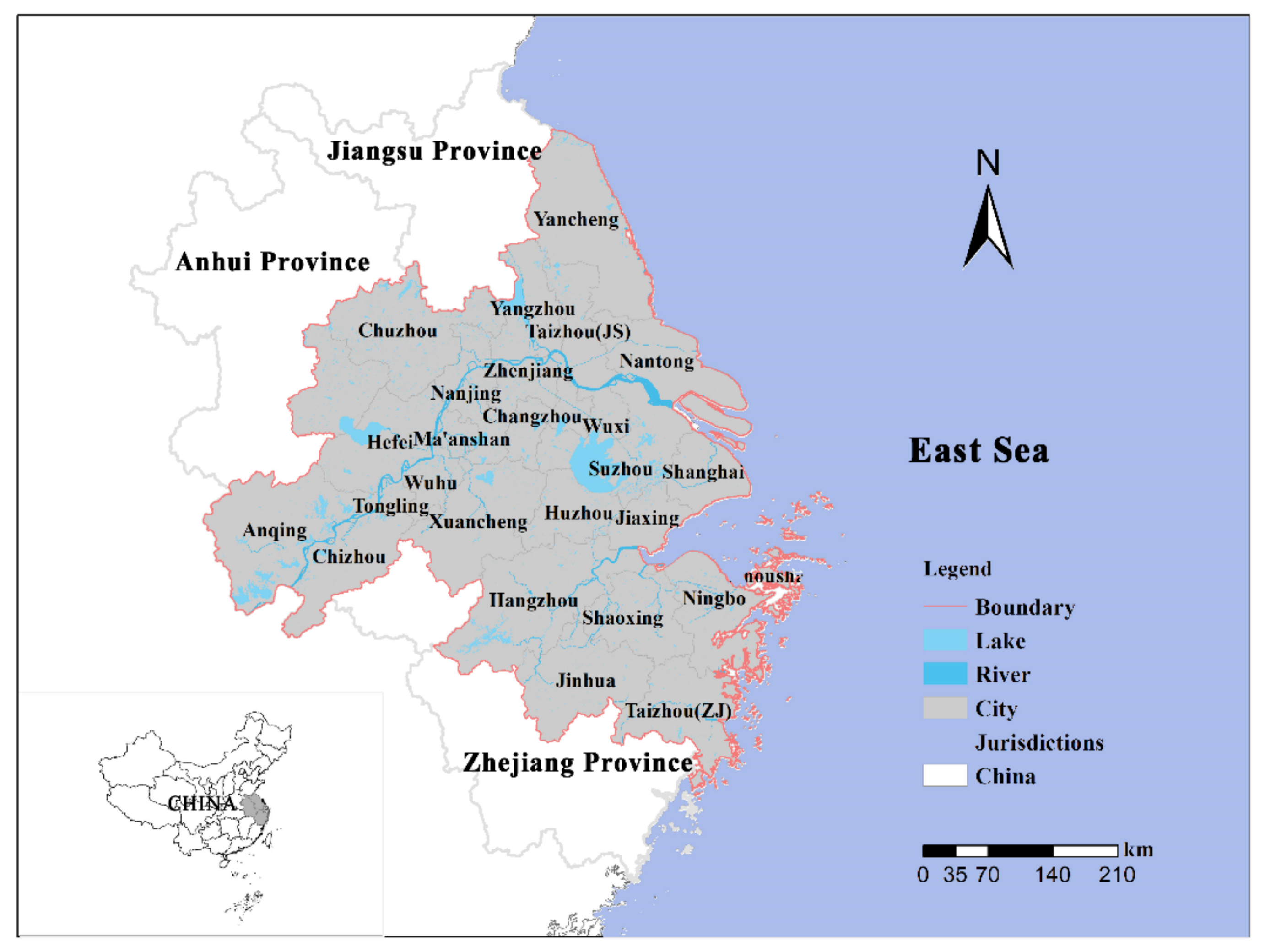
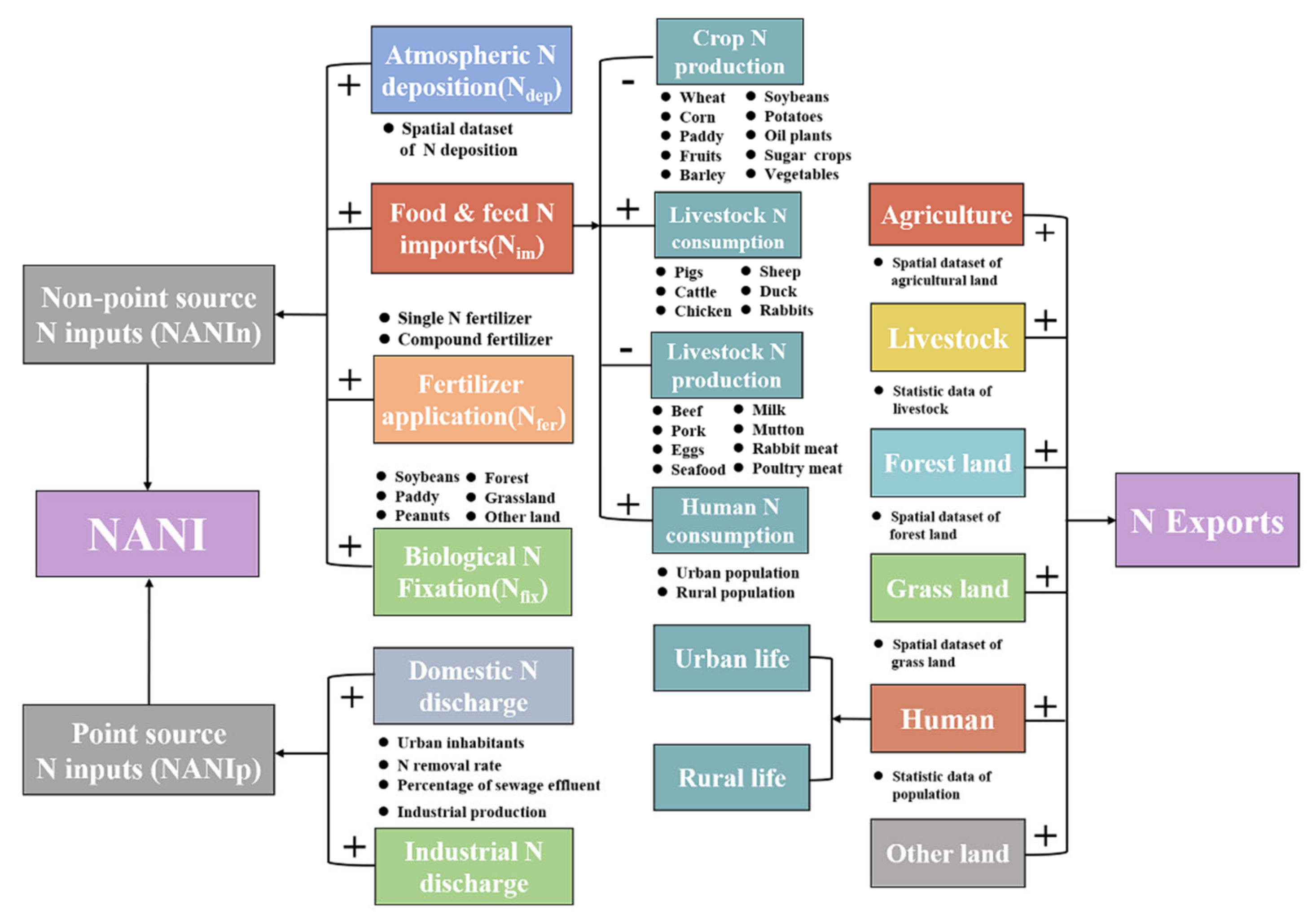
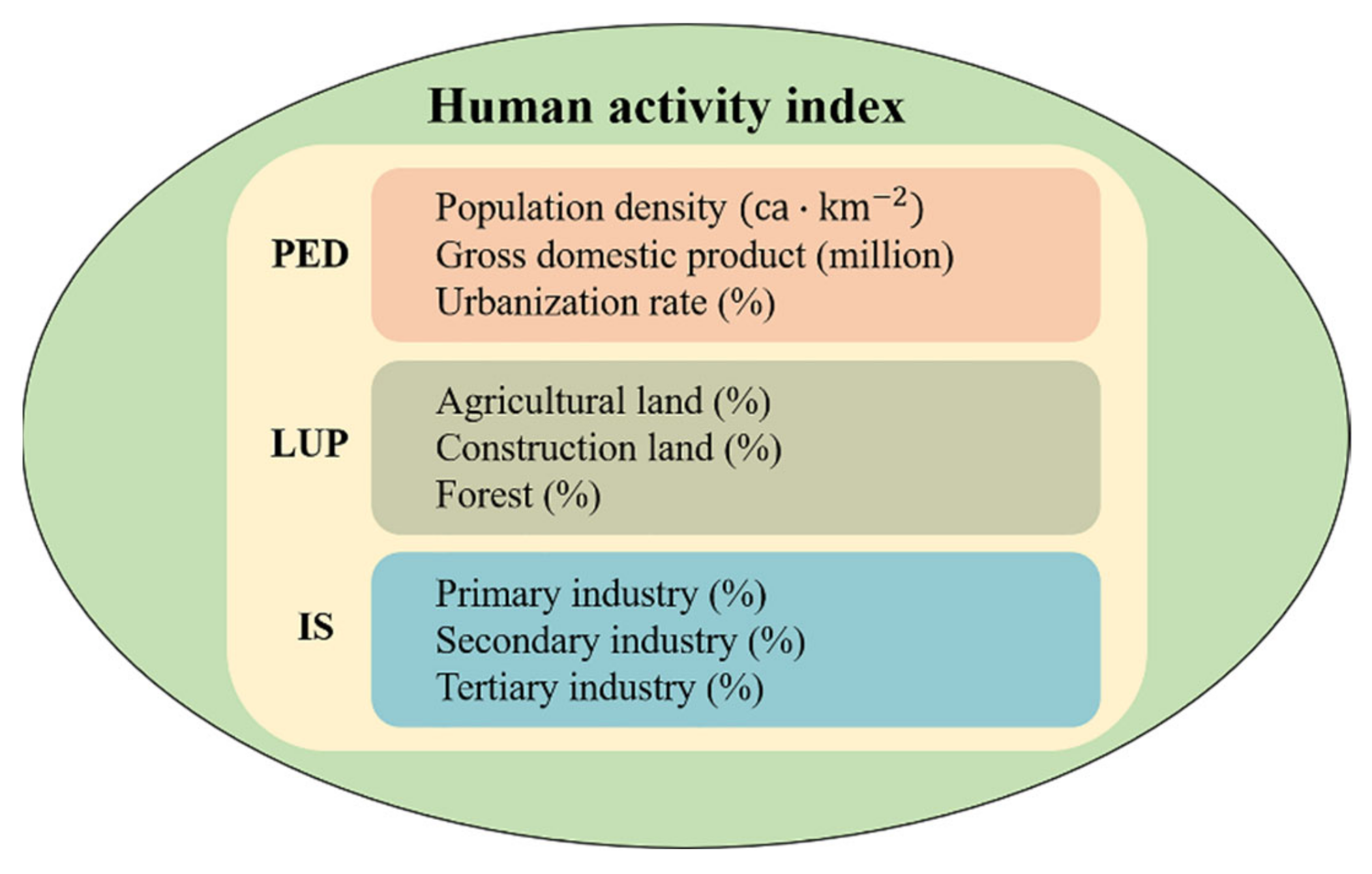
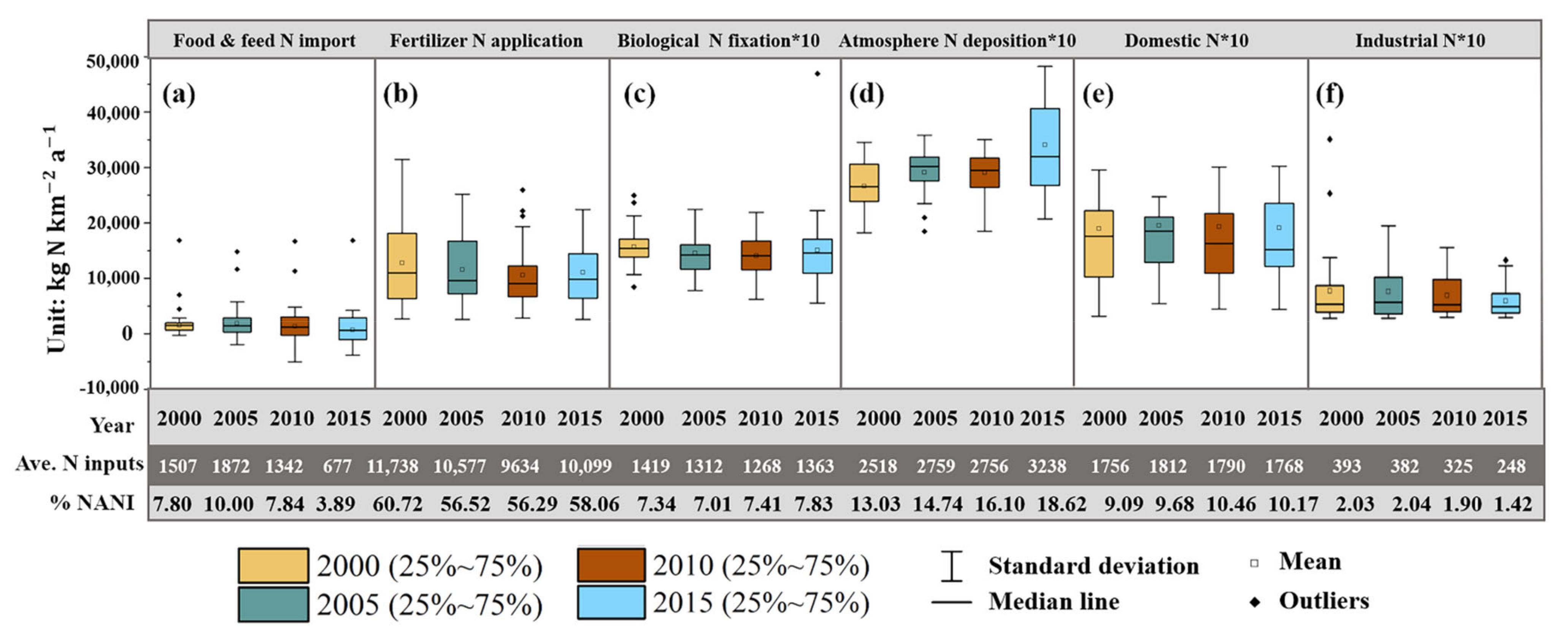

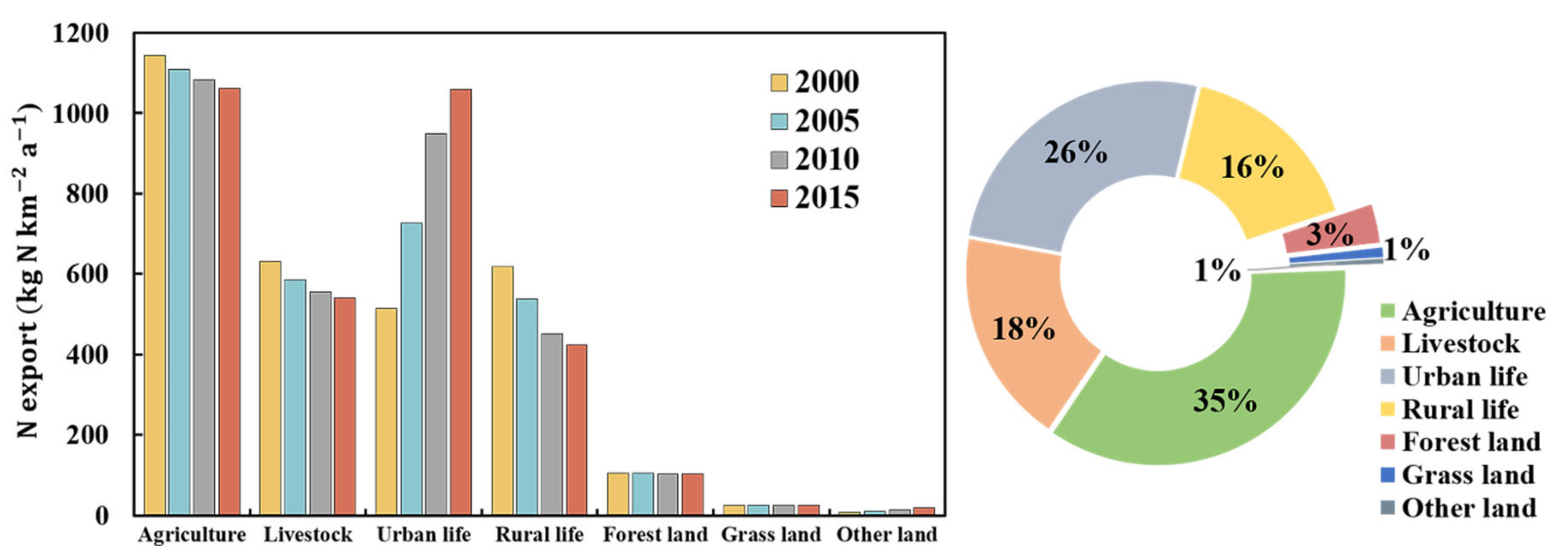
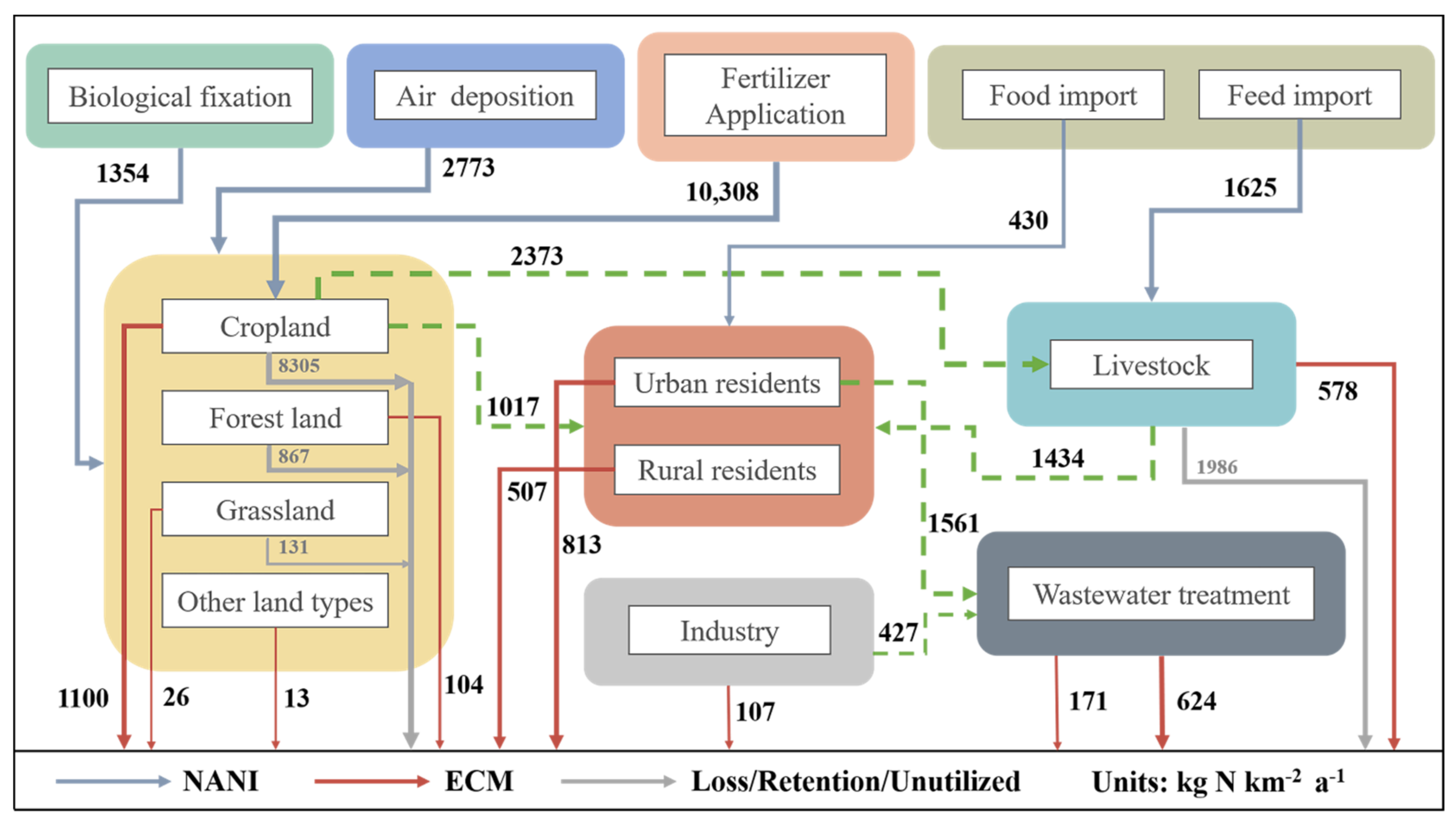

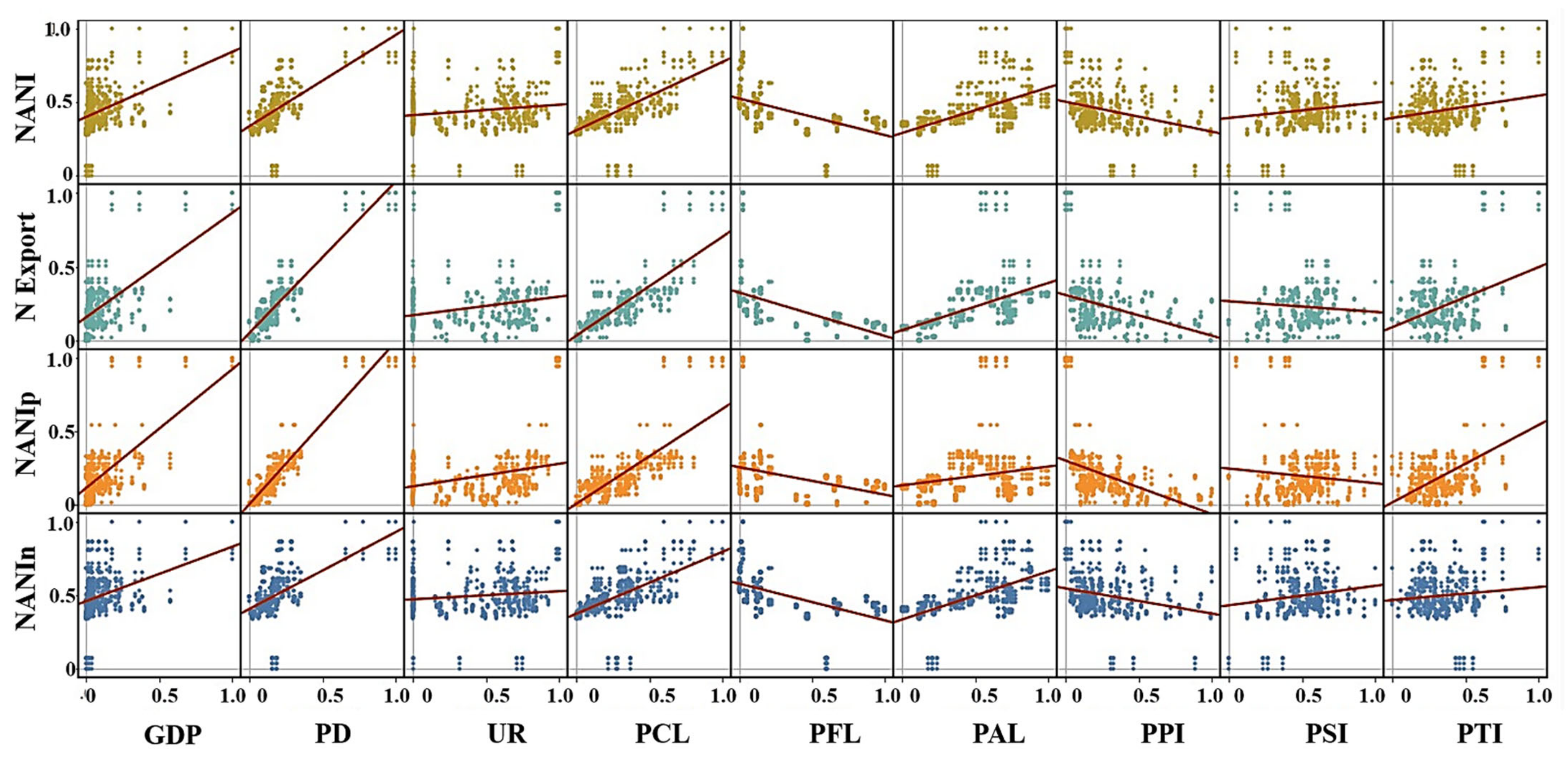
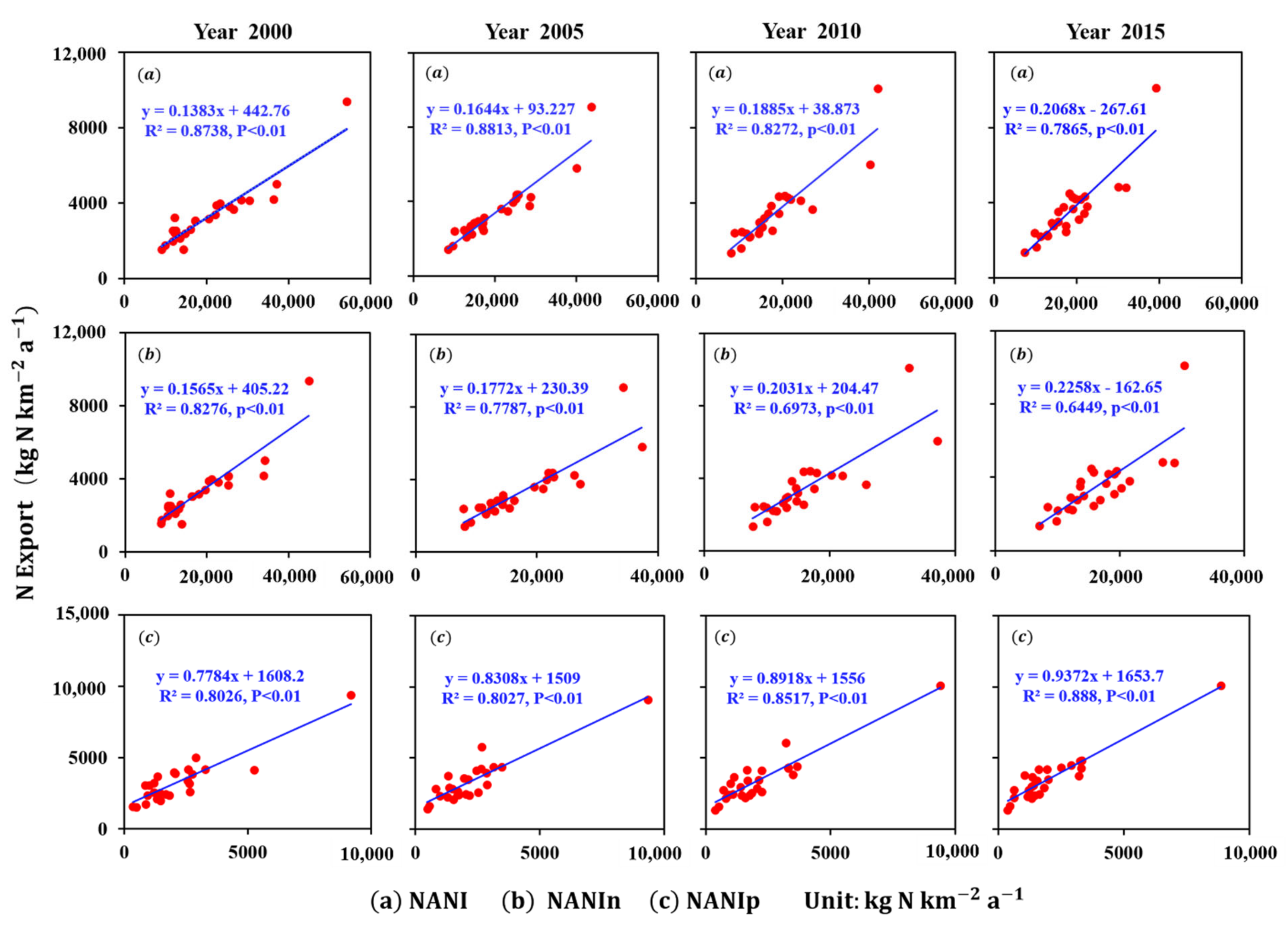
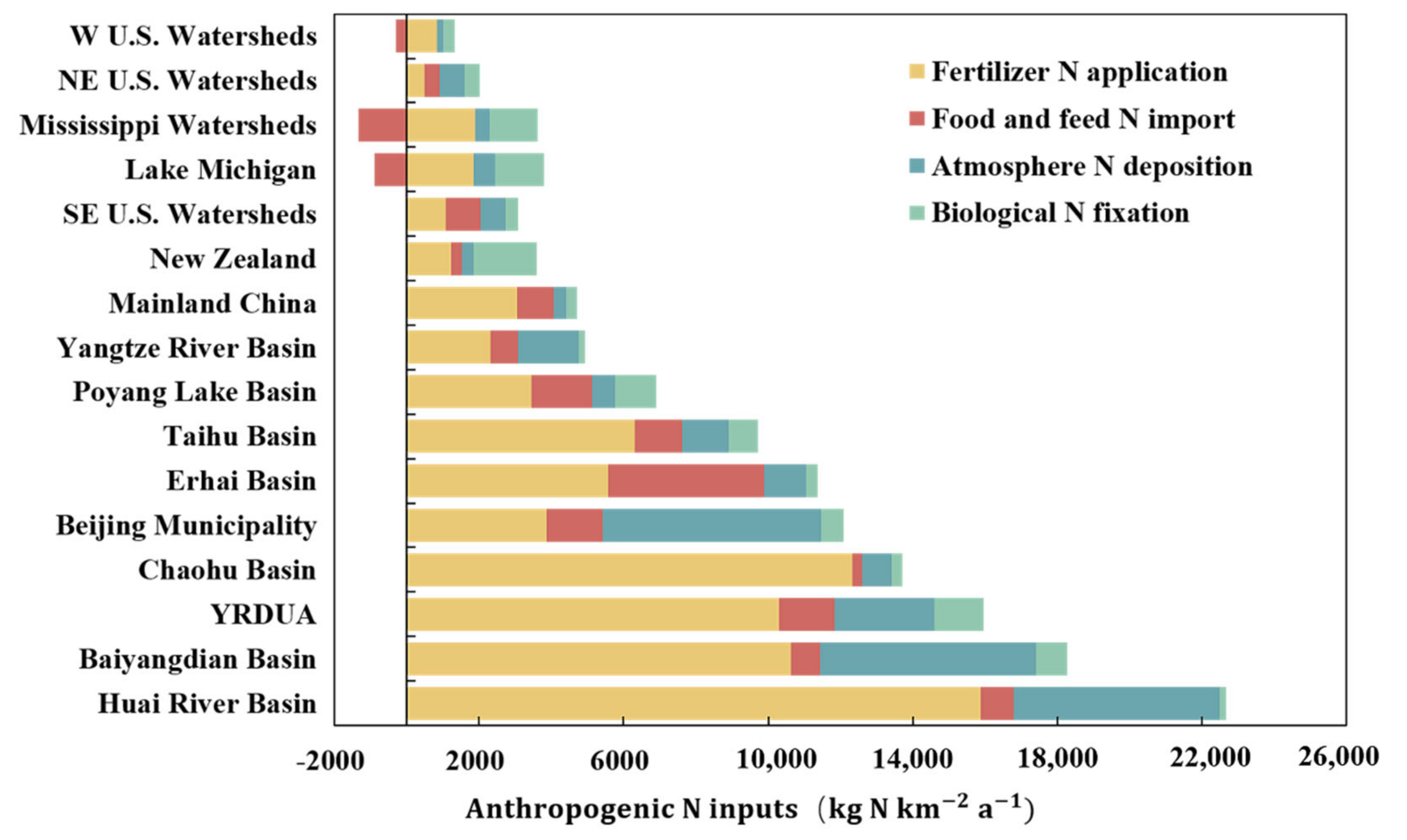
| Year | NANI | NANIn | Proportion of NANIn | NANIp | Proportion of NANIp |
|---|---|---|---|---|---|
| 2000 | 18,766.79 | 16,944.52 | 90.29% | 1822.27 | 9.71% |
| 2005 | 18,355.65 | 16,466.27 | 89.71% | 1889.39 | 10.29% |
| 2010 | 17,094.40 | 15,286.75 | 89.43% | 1807.65 | 10.57% |
| 2015 | 16,798.08 | 15,119.49 | 90.01% | 1678.59 | 9.99% |
Publisher’s Note: MDPI stays neutral with regard to jurisdictional claims in published maps and institutional affiliations. |
© 2021 by the authors. Licensee MDPI, Basel, Switzerland. This article is an open access article distributed under the terms and conditions of the Creative Commons Attribution (CC BY) license (http://creativecommons.org/licenses/by/4.0/).
Share and Cite
Ding, N.; Zhu, J.; Li, X.; Wang, X. Spatiotemporal Dynamics of Nitrogen Budgets under Anthropogenic Activities in Metropolitan Areas. Sustainability 2021, 13, 2006. https://doi.org/10.3390/su13042006
Ding N, Zhu J, Li X, Wang X. Spatiotemporal Dynamics of Nitrogen Budgets under Anthropogenic Activities in Metropolitan Areas. Sustainability. 2021; 13(4):2006. https://doi.org/10.3390/su13042006
Chicago/Turabian StyleDing, Ning, Jingfeng Zhu, Xiao Li, and Xiangrong Wang. 2021. "Spatiotemporal Dynamics of Nitrogen Budgets under Anthropogenic Activities in Metropolitan Areas" Sustainability 13, no. 4: 2006. https://doi.org/10.3390/su13042006
APA StyleDing, N., Zhu, J., Li, X., & Wang, X. (2021). Spatiotemporal Dynamics of Nitrogen Budgets under Anthropogenic Activities in Metropolitan Areas. Sustainability, 13(4), 2006. https://doi.org/10.3390/su13042006






